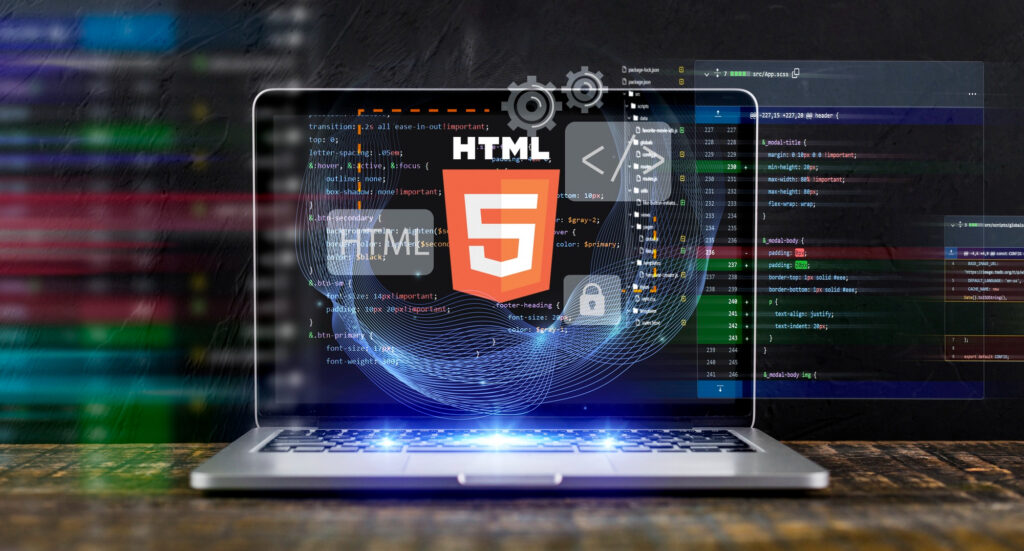Frontend frameworks have become the cornerstone for creating such engaging and responsive web applications. These frameworks provide developers with a structured environment to build the client-side of the web. They offer pre-written, standardised code in the form of components and tools, making it easier to create a maintainable and scalable codebase.
As we delve into the world of frontend frameworks, we find a plethora of options, each with its unique features, benefits, and quirks. From the heavyweights that have dominated the field for years to the rising stars that are bringing new paradigms to the table. The choice of the right frontend framework can be both overwhelming and critical for the success of your app.
What are Frontend Frameworks?
A frontend framework is a suite of standardised, pre-written code libraries and tools that are used to facilitate the development of the client-side of a website or web application. The client-side, often referred to as the frontend, is the part of the web that users interact with directly—it includes everything that users experience directly: text, images, sliders, buttons, animations, and more.
Purpose of Frontend Frameworks
Frontend frameworks serve several key purposes in web development:
Rapid Development: They accelerate the development process by providing a collection of ready-to-use code components and templates.
Consistency: By using a common set of principles and components, frameworks ensure a consistent structure across different parts of an application or even across different projects.
Responsiveness: Many frameworks come with a responsive design in mind, making it easier to create web applications that work smoothly on a variety of devices and screen sizes.
Maintainability: With a structured codebase and component reusability, frameworks make it easier to maintain and update web applications.
Performance: Frameworks often include optimisations to enhance the performance of websites, such as minimising the code and reducing the load time.
Top Frontend Frameworks To Consider For Development
These are the top 6 frontend frameworks that have been recognized for their remarkable features and community engagement.
React
Component-Based Architecture: React‘s design revolves around reusable components, making it easier for developers to manage component state and data across complex applications.
JSX Syntax: React uses JSX, a syntax extension that combines HTML with JavaScript, providing a more intuitive way to construct the user interface.
Virtual DOM: To optimise rendering performance, React implements a virtual DOM that efficiently updates the browser’s DOM.
One-Way Data Binding: React’s data flow structure simplifies the tracking and management of data within an application.
Rich Ecosystem: With a vast array of libraries and a strong community, React offers extensive resources for developers, including high-quality documentation and tutorials.
Angular
TypeScript-Based: Angular utilises TypeScript, which brings static typing and object-oriented elements to the framework, enhancing code quality and maintainability.
MVC Framework: Angular adheres to the Model-View-Controller pattern, allowing a separation of concerns, which simplifies the development process.
Two-Way Data Binding: This feature keeps the model and view in sync automatically, making updates and user interface changes more streamlined.
Dependency Injection: Angular has a built-in dependency injection system, which promotes reusability of components and services.
Comprehensive Tooling: Angular provides a full suite of tools for testing, animation, and more, making it a robust choice for enterprise-level applications.
Vue.js
Reactivity & Composability: Vue is designed to be both reactive and composable, offering an approachable and optimised model for managing application state.
Template Syntax: Vue uses an HTML-based template syntax that allows developers to declaratively bind the rendered DOM to the underlying application data.
Virtual DOM: Similar to React, Vue leverages a virtual DOM to apply changes to the DOM in the most efficient way possible.
Ease of Integration: Vue is known for its capability to be incrementally adopted, making it a flexible choice for projects that need to integrate a framework bit by bit.
Svelte
No Virtual DOM: In contrast to React and Vue, Svelte compiles components at build time, removing the need for a virtual DOM and resulting in faster runtime performance.
Less Code: Svelte reduces boilerplate by inferring behaviour from the code you write, leading to more concise and readable codebases.
Reactive Updates: Svelte ensures that the DOM is updated reactively and efficiently whenever the state of the app changes.
Built-In Transitions: Svelte includes transition effects out of the box, allowing for more engaging user interfaces with less effort.

jQuery
Simplicity and Ease of Use: jQuery simplifies complex JavaScript operations, making it accessible for developers of all skill levels.
Large Community Support: Being one of the earliest frontend frameworks, jQuery has a considerable community, providing a wealth of plugins and solutions.
DOM Manipulation: jQuery offers powerful features for HTML/DOM manipulation, as well as CSS manipulation, which are straightforward to implement.
AJAX Support: With jQuery, developers can easily manage AJAX requests, which is essential for dynamic content loading.
Ember.js
Convention over Configuration: Ember.js emphasises a set of conventions to follow, which helps in reducing the decision-making overhead for developers.
Robust Routing: Ember provides a consistent and feature-rich routing mechanism, which simplifies the navigation and organisation of complex applications.
Templating Engine: It uses Handlebars templating engine to create clean and logic-less templates, contributing to clearer and more maintainable code.
Ember CLI: Ember comes with a command-line interface that streamlines tasks like creating new projects, adding new files, and building for production.

Points To Consider While Choosing Frontend Frameworks
When choosing a frontend development framework, it’s essential to consider various factors that can influence both the immediate and long-term success of your project.
Project Requirements
Complexity: Assess the complexity of the application you are building. Some frameworks are better suited for large-scale, complex applications, while others excel at simple, single-page applications.
Functionality: Determine the specific functionalities needed, such as real-time data, SEO friendliness, or mobile responsiveness, and choose a framework that caters to these needs.
Scalability: If you anticipate growth in your application’s user base or functionality, look for a framework that scales well.
Performance Considerations
Speed: Evaluate the performance implications of the framework, including load times, rendering speeds, and updates.
Resource Efficiency: Some frameworks require more resources than others, which can affect hosting costs and user experience, particularly on mobile devices.
Ecosystem and Tooling
Libraries and Plugins: Check the availability of libraries, plugins, and additional tools that can speed up development and offer extended functionalities.
Compatibility: Ensure that the framework is compatible with other tools and systems you plan to use, such as backend frameworks, databases, and deployment platforms.
Longevity and Future-Proofing
Maintenance and Updates: Look at the framework’s history of maintenance and frequency of updates. A well-maintained framework is less likely to become obsolete.
Roadmap: Review the framework’s development roadmap to ensure it aligns with future trends and technologies.
Documentation and Resources
Quality of Documentation: Good documentation can greatly speed up the learning process and serve as a reference during development.
Training Resources: Availability of training resources, such as online courses, tutorials, and books, can be crucial for upskilling the team.

Licensing and Costs
Open Source vs Proprietary: Most frontend frameworks are open source, but it’s important to understand the licensing terms to ensure they align with your project’s needs.
Costs: Consider any potential costs associated with using the framework, including licensing fees or the need for premium plugins.
Integration and Compatibility
Interoperability: The chosen framework should work well with other systems and technologies in your stack.
Server-Side Rendering (SSR): For SEO purposes or performance reasons, you may require SSR, which not all frameworks support natively.
Conclusion
The choice of a frontend framework is a pivotal decision that can define the success of your application. Whether you prioritise performance, ease of use, scalability, or a vibrant community, there’s a framework out there that aligns with your vision.
The optimal choice depends on a careful evaluation of your requirements, team expertise, and the specific demands of your project. By considering the insights provided here, you’re well on your way to making an informed decision that will set the foundation for a robust, future-ready app.
However, if you’re still on the fence or need professional guidance to bring your vision to life, Appscrip is here to assist. With our comprehensive app development solutions, we can help you navigate the complexities of frontend frameworks and deliver an exceptional product tailored to your business needs. Our team of seasoned developers is adept at harnessing the power of cutting-edge frontend technologies to create applications that stand out in a crowded digital space.
Contact Appscrip today to explore how we can elevate your app from concept to reality, ensuring a captivating user experience that drives engagement and growth. Let’s build something remarkable together.










Thanks For The Information;
Keep Posting More!